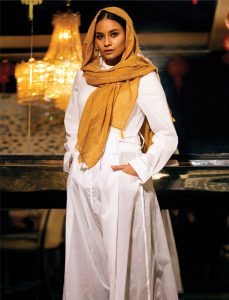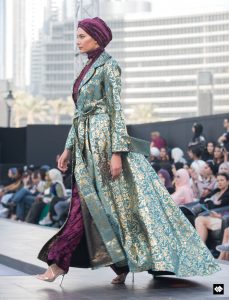The modest fashion industry during its nascent stage began as a grassroots movement spearheaded by an expanding generation of young Muslim women looking to state their Muslim identity. Once modest fashion began emerging as a category unto itself, designers and entrepreneurs alike insisted that the fashion category be named ‘modest fashion’ to be more inclusive, since the sector also caters to professional women and body-conscious women as well.
Mapping the Beginnings of Modest Fashion
 Over the past decade, modest fashion has made its mark as a defining style. The growing trend for loose layers and oversize silhouettes has brought fans – religious and secular – together. The fashion trend has also seen western brands eyeing to buy into the lucrative Muslim consumer market. Along with this shift, there has been a significant rise in the acceptability of the headscarf, making it a covetable commodity within the western fashion scene. Notable global brands like Nike, Uniqlo, Liberty, Tommy Hilfiger and Dolce & Gabbana have been selling fashionably tailored hijabs in recent years. This growing fashion sector is no longer a niche market. With uptakes in high fashion to the high street, more brands and stores have felt encouraged to embrace the concept and advertise fashionable styles in campaigns and on catwalks.
Over the past decade, modest fashion has made its mark as a defining style. The growing trend for loose layers and oversize silhouettes has brought fans – religious and secular – together. The fashion trend has also seen western brands eyeing to buy into the lucrative Muslim consumer market. Along with this shift, there has been a significant rise in the acceptability of the headscarf, making it a covetable commodity within the western fashion scene. Notable global brands like Nike, Uniqlo, Liberty, Tommy Hilfiger and Dolce & Gabbana have been selling fashionably tailored hijabs in recent years. This growing fashion sector is no longer a niche market. With uptakes in high fashion to the high street, more brands and stores have felt encouraged to embrace the concept and advertise fashionable styles in campaigns and on catwalks.
According to the Year in Fashion 2019 report by Lyst – the largest global fashion search platform, the year 2019 marked a whopping 90% increase in internet searches for ‘modest fashion’. Western fashion brands are eager to nab their share of the promising market. The global fashion industry stood at US$283bn in 2018. This figure is expected to grow exponentially to US$402bn by the year 2024. The monumental growth of the industry is propelled mainly by a Muslim consumer market of 1.8bn and growing, expected to account for 31% of the world’s population by 2050. With two-thirds of all Muslims being under the age of 30, this makes them the world’s youngest consumer segment.
A Growing Market for Modest Fashion
The sector has expanded beyond traditional elements such as the hijab to include loose-fitting and less revealing clothing. The modest fashion industry has grabbed the limelight as a popular style movement and an immensely lucrative market. With hijabi models strutting down catwalks to the modest fashion bloggers amassing a following of hundreds of thousands on Instagram, these torchbearers of the modest fashion legacy have highlighted the fact that modest consumers are style-conscious and possess major spending power.
Alongside, these modest fashionistas have taken the internet by storm when in May 2020 they partook in viral lockdown games like the “don’t rush” makeup challenge. With a bevy of modest fashion bloggers hailing from all faiths making their presence known on the web, modesty is being integrated as a fashion staple in the blogging world. With a wider acceptability of modest fashion, consumers can rely on accessible and affordable modest fashion e-commerce which is continuing to flourish owing to notable luxury e-tailers like Net-Porter, Shopbop and Farfetch introducing curated modest selections on their websites.
Prospects of Modest Fashion for Bangladesh
 The use of modest fashion is prevailing in Muslim-majority countries. The industry has an enormous prospect of infiltrating Non-Muslim markets too. According to a report in Textile Today, the modest fashion industry is gearing up to be worth US$2.3trillion without a financial market with 20% annual growth. Alongside, the modest fashion industry is also creating a promising market segment for garment-producing nations. Bangladesh, with its reputation as the second-largest apparel producing nation in the global market, has an incredible opportunity to grab a sizeable chunk of market share of the modest fashion industry.
The use of modest fashion is prevailing in Muslim-majority countries. The industry has an enormous prospect of infiltrating Non-Muslim markets too. According to a report in Textile Today, the modest fashion industry is gearing up to be worth US$2.3trillion without a financial market with 20% annual growth. Alongside, the modest fashion industry is also creating a promising market segment for garment-producing nations. Bangladesh, with its reputation as the second-largest apparel producing nation in the global market, has an incredible opportunity to grab a sizeable chunk of market share of the modest fashion industry.
Even though Bangladesh’s export of Islamic ethnic wear is not significant, however, with the cooperation of traditional local fashion brands, and an army of women entrepreneurs in Bangladesh Small and Cottage Industry Corporation (BSCIC), SME Foundation, Jatiyo Mohila Sangstha and National Association of Small Cottage Industries of Bangladesh (NASCIB), Bangladesh can reap the benefits of a modest fashion industry ripe with opportunities.
